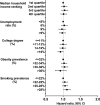Racial and geographical disparities in oesophageal cancer incidence, mortality and county-level risk factors in the state of Mississippi between 2003 and 2019: a descriptive analysis
- PMID: 38292243
- PMCID: PMC10827340
- DOI: 10.1136/bmjph-2023-000316
Racial and geographical disparities in oesophageal cancer incidence, mortality and county-level risk factors in the state of Mississippi between 2003 and 2019: a descriptive analysis
Erratum in
-
Correction: Racial and geographical disparities in oesophageal cancer incidence, mortality and county-level risk factors in the state of Mississippi between 2003 and 2019: a descriptive analysis.BMJ Public Health. 2024 Jan 19;2(1):e000316corr1. doi: 10.1136/bmjph-2023-000316corr1. eCollection 2024 Jun. BMJ Public Health. 2024. PMID: 40018196 Free PMC article.
Abstract
Background: Oesophageal cancer is one of the most aggressive cancers. The aim was to describe the disparities in oesophageal cancer incidence and mortality, and county-level factors in the state of Mississippi from 2003 to 2019 by sex, race, and geolocation.
Methods: This study used data from the Mississippi Cancer Registry, linked to county-level data from the Behavioral Risk Factor Surveillance System, the American Community Survey, and the Institutes for Health Metrics and Evaluation. We estimated age-standardised incidence (crude ASR) and mortality rates (crude AMR), mortality-incidence rate ratio and average annual percent change (AAPC) in rates by sex, race, and geolocation, using the Joinpoint Software V.5.0. We further calculated relative risks for oesophageal cancer using age-adjusted quasi-Poisson regression for each county-level factor including smoking, obesity, college degree completion, unemployment rate and median household income ranking within the state.
Results: Between 2003 and 2019, a total of 2737 oesophageal cancer cases and 2259 oesophageal cancer deaths occurred in Mississippi. Black men had the greatest reduction in oesophageal cancer incidence and mortality despite high rates (crude ASR2019=10.5, crude AMR2019=7.3 per 100 000; AAPCincidence=-3.7%, p<0.001 and AAPCmortality=-4.9%, p<0.001). The reduction was largely driven by decreases in the non-Delta region (AAPCincidence=-4.2%, p<0.001), while incidence rate remained high among Black men in the Delta region (crude ASR2019=15.4 per 100 000, AAPCincidence=-1.8%, p=0.3). The rates among White men were relatively stable (crude ASR2019=8.5, crude AMR2019=7.6 per 100 000; AAPCincidence=0.18%, p=0.7, AAPCmortality=-0.4%, p=0.6). County-level smoking prevalence (in quartile, p=0.02) was significantly associated with oesophageal cancer incidence.
Discussion: This study highlights the importance of targeted interventions to address the persistent high incidence rate of oesophageal cancer among Black men in the Delta region.
Conflict of interest statement
None declared.
Figures



References
Grants and funding
LinkOut - more resources
Full Text Sources
